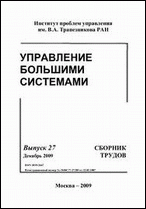|
This article is cited in 1 scientific paper (total in 1 paper)
Control in Social and Economic Systems
Mathematical model of intersectoral coordination of development strategies (on the example of healthcare and aircraft industry)
I. E. Seleznevaa, V. V. Klochkovab, S. Yegoshinb
a V.A. Trapeznikov Institute of Control Sciences of RAS, Moscow
b National Research Center «Institute named after N.E. Zhukovsky», Zhukovsky
Abstract:
The article examines the expediency of joint coordination of different industries policies to create products, including public goods. The article also assesses losses due to imperfect coordination. For this purpose, the paper proposes a model of choosing strategies of the interacting industries development (on the example of healthcare and aircraft industry, in the part of sanitary aviation development) with varying degrees of their coordination with each other and with national interests. Egoistic strategies of industries are studied, when each industry has its own private utility function that does not coincide with the public utility function, and strategies of industries with co-directed interests, when the private utility functions of industries are co-directed with the public utility function, but there is no information interaction between industries. The costs of industries and the total costs of the state are calculated depending on the degree of policy coordination between them, the rules of interaction in the creation of public goods and the policy of their financing by the state. The public welfare losses from imperfect coordination of development strategies are estimated. Based on realistic initial data on the parameters of industries, a strategy, that leads to the worst consequences for public welfare, has been determined. The consequences criticality of the presence of costly industries incentives and information barriers is compared. The necessary conditions of effective, from the point of the national economy view, interaction between industries are determined, such as the formation of cost-effective mechanisms (incentives) for industries and the availability of mathematical models that allow all parties to clearly see their possible costs and benefits, and calculate optimal solutions.
Keywords:
industry development strategy, utility function, intersectoral coordination, selfish strategies, strategies with uncoordinated policies, integrated aviation system.
Received: December 6, 2021
Published: September 30, 2022
Citation:
I. E. Selezneva, V. V. Klochkov, S. Yegoshin, “Mathematical model of intersectoral coordination of development strategies (on the example of healthcare and aircraft industry)”, UBS, 99 (2022), 57–80
Linking options:
https://www.mathnet.ru/eng/ubs1118 https://www.mathnet.ru/eng/ubs/v99/p57
|

| Statistics & downloads: |
| Abstract page: | 38 | | Full-text PDF : | 8 | | References: | 12 |
|




 Contact us:
Contact us: Terms of Use
Terms of Use
 Registration to the website
Registration to the website Logotypes
Logotypes








 Citation in format
Citation in format 
